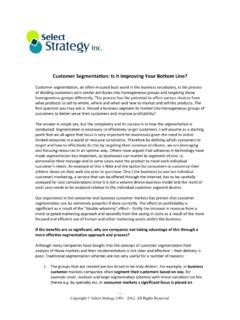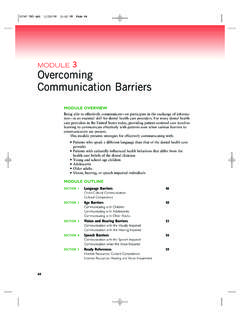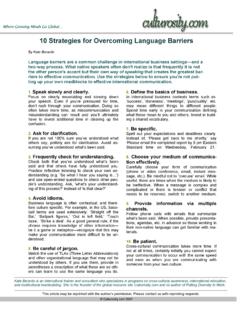Transcription of Select Strategy
1 Select Strategy 1 877 HR ASSET. 1 877 472 7738. Improving Performance by Breaking Down Organizational Silos Understanding Organizational barriers Restructuring initiatives have become common rather than exceptional occurrences. Some are successful, others not. Once new organizational structures are in place, they typically have their limitations. Virtually every organizational chart or model, in medium to large sized companies, divides employees into business units and/or departments. This is necessary to focus skills and pool common interests and resources to achieve specific company objectives. There is however, a downside that is often not catered for a silo effect which impacts performance. In this paper, the silo effect will be defined, the dangers presented by silos will be briefly outlined, and an approach and suggestions to reduce these silos will be discussed. The Silo Effect Defined Silos may be defined as groups of employees that tend to work as autonomous units within an organization.
2 They show a reluctance to integrate their efforts with employees in other functions of the organization. The effect has the propensity to exist throughout a Company, or between subsidiaries within a wider corporation, resulting in division and fragmentation of work responsibilities within the organization. Departments and business units can fragment into even smaller silos based on strong personal bonds, and areas of commonality that differentiate groups of employees from the rest of their department. Silos are a common occurrence, as they exist to a greater or lesser extent in most companies. The area of an organization in which silos exist will be termed the division or area' for the purposes of this paper irrespective of whether it takes the form of a department, business unit or any other structure, purely for reading comfort. Individuals within a given division tend to interact with other employees in their own area more than with employees outside them.
3 This leads them to bond with each other, and feel comfortable working with employees in their area of the Company or in-group . In order to be allocated to the same division, employees typically have common interests and often common abilities and work values. Many members may belong to the same professional associations or have embarked on similar courses of study. Thus an in-group is strengthened by commonality on a variety of dimensions between the group members. This is exacerbated by perceptions a given division may have of differences between themselves and other divisions. Employees in another division may be united within the in-group's perception as a separate team that operates in different ways from themselves, or out-group . Out-groups are typically perceived to have different interests and group personalities. They are often believed to have different work values and priorities. -1 . Copyright Select Strategy 2002. All Rights Reserved.
4 What Factors Contribute to Silo Formation? Incompatible Objectives In understanding silo formation it is important to realize that individual divisions often have necessary, but conflicting priorities. For instance, an artistic department in a Company may have artistic excellence, as its greatest priority, whilst the financial department may be concerned with profit, and cost reduction or profit generating activities in the artistic department. Meetings In many instances it is easy and convenient for employees to restrict most intra-organizational meetings within a daily schedule to their own division, and focus on its primary objectives. This keeps employees in their comfort zones from both a social and work perspective. Conflict with differing priorities associated with other parts of the organization, is avoided. Incentives There are often major incentives for an employee to restrict most personal interactions to their own division.
5 Employees generally report to members of their own division. Performance is appraised and compensation determined based mostly on perceptions from within their division. Work that is required of the employees may stimulate them to focus work efforts within the skill pool of their own division. People sharing similar or complimentary skills may be repeatedly allocated to the same tasks. It is often most viable to form professional networks within the department of people who conduct similar work and belong to the same professional bodies. Sub-cultures Importantly, when left to their own devises, employees within an in-group form and entrench their own sub-culture that becomes distinct from the rest of the organization. (The term sub- culture refers to the creation of new cultural characteristics within a subgroup of an organization.) This sub-culture makes it increasingly difficult for other members of the company to integrate into the group.
6 Outside employees may have difficulty in understanding and articulating this culture and be unable to conform to the social norms it requires. Employees within a given division or in-group often socialize more with each other even at communal office functions. Members of a given out-group may be and feel unwanted by the in- group within a social context. Employees will tend to feel most comfortable in their own division with their friends. Alternative sub-cultures are hard to crack, different and less inviting. Hence organizational silos are created. -2 . Copyright Select Strategy 2002. All Rights Reserved. Silo Formation There are 3 types of influences that cause silos. Those internal to the silo itself, those imposed by the Company and those that stem from the outside world. These three factors interact to form silos such that each impacts the others, thereby reinforcing the silo system. External Environment Outside customer demands require focused efforts & thought on work-related issues.
7 Organizational Influences Company structures such as incentive systems task allocation systems & office layout limit interpersonal interaction & co-operation between departments Internal Influences Sub-culture is formed based on common knowledge, skills, learning & group experiences. -3 . Copyright Select Strategy 2002. All Rights Reserved. Why Silos are Dangerous for an Organization communication barriers Silo formation is undesirable because it creates barriers to communication between divisions. This facilitates divisions working in isolation, which negatively impacts the work process because there is a lack of integration between functions. This is particularly serious in service-based organizations that compromise on the ability to offer an integrated solution. In virtually every Company where silo effects are present, various broad organizational objectives and goals are not optimally achieved, because the collective brain power and work potential of the organization cannot be fully harnessed.
8 Minimal Co-operation between Areas Employees do not co-operate with and assist other departments in the Company as much as they should, costing the firm time, effort and money. Importantly within a Company or Group that offers a variety of products or services, employees may be reluctant to refer work to other sectors of the Company. Given that the rest of the Company is not a priority for them, products and services offered by other members of the Group may not be on their radar screens. The Psychology of Feeling a Victim'. There is broad recognition of a communication problem of which everyone feels a victim. This is unfortunate because it is difficult for existing members of the firm to break down the communication barriers in light of a pervasive feeling of helplessness. The individual employee's perception of the problem tends to be that it is insurmountable. Employees each feel that it is not their fault and exists outside their personal control.
9 The communication breakdowns lead to errors and finger pointing, as employees want to distance themselves from errors, and avoid taking responsibility for mistakes that could impede their career progression or credibility within the Company. Anger is often directed towards certain people who are fairly or unfairly identified as being at the root of the problem. Finger pointing will also tend to reinforce in-group out-group psychology, as people prefer to antagonize members of other divisions and feel safer placing blame further away from their own divisions. Silos are Long Lasting Once silos are constructed, they cannot be easily eliminated. People within silos have a propensity to form lasting friendships. Their subcultures become entrenched. They often socialize after hours with people within their silos and create a social distance between themselves and the rest of the company. As time passes, this distance between silos becomes more difficult to narrow.
10 -4 . Copyright Select Strategy 2002. All Rights Reserved. Why Silos are dangerous: The downward spiral Each division is focused on its own primary objectives Divisions do not communicate sufficiently or effectively because of the factors that feed into silo formation Divisions do not co-operate with each other because they are uninformed The lack of co-operation breeds resentment and a reciprocal lack of giving Division members feel isolated from other divisions and focus work effort within their own division Each division focuses on it's own primary objectives -5 . Copyright Select Strategy 2002. All Rights Reserved. Overcoming the barriers of a Silo Organizational Structure Components of a Solution: The Process The elimination of silos is the end result of a process that begins with the articulation of a definition and explanation of the silo situation within the given organization. Employees need to be consulted and given the opportunity to offer suggestions on how to eliminate the silos within the Company.








